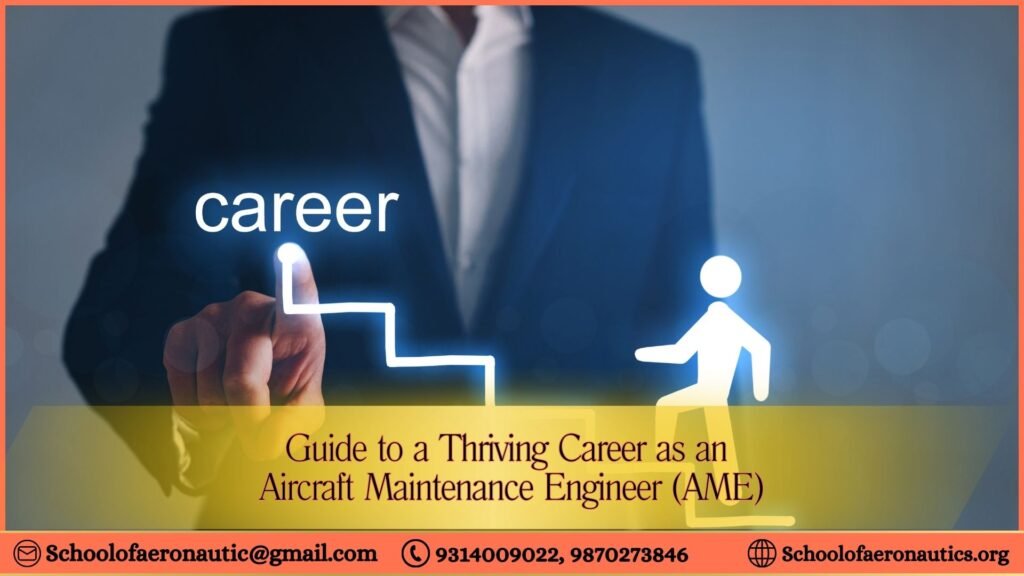Guide to a Thriving Career as an Aircraft Maintenance Engineer (AME)

Then’s a companion to erecting a successful career as an Aircraft conservation mastermind( AME), covering everything from qualifications to career growth openings
1. Understand the part of an Aircraft maintenance engineering
AMEs are responsible for the safety and airworthiness of aircraft. They conduct examinations, repairs, and conservation, icing that all systems meet strict aeronautics norms.
AMEs generally specialize in either mechanical( airframe and machine systems) or avionics( electrical and electronic systems) fields, under the DGCA’s license orders( order A, B1, B2).
2. Meet the Educational and Licensing Conditions
Educational Qualification Complete 10+ 2 with Physics, Chemistry, and Mathematics( PCM) or a parchment in engineering( AICTE- honored).
DGCA- approved AME Course Enroll in a DGCA- approved AME program, which generally lasts 2- 4 times.
Licensing Exams After completing the course, pass the DGCA licensing examinations. Licensing is divided into order A, B1( mechanical), or B2( avionics).
internship/ Practical Training After passing examinations, gaining practical experience under the supervision of certified AMEs is pivotal.
3. Develop Key Chops for Success
Technical Proficiency Build deep knowledge in aircraft mechanics, systems, and individual tools.
Attention to Detail Aircraft conservation demands high perfection and compliance with safety regulations.
Problem- working Chops You’ll need to diagnose issues snappily and suppose on your bases.
Rigidity The field is ever- evolving, so keeping up with new technologies and systems is essential.
Communication Chops Effective communication with aviators, masterminds, and nonsupervisory authorities is crucial for safety.
4. Gain Practical Experience
On- the- Job Training( OJT) Pursue externships or internships during your course to gain hands- on experience.
Real- World Applications Work in surroundings like airlines, conservation, form, and Overhaul( MRO) installations, and airfields.
Stay streamlined with Regulations Aviation norms evolve, so regularly review updates from DGCA, FAA( U.S.), and EASA( Europe).
5. Progress Your Career
Specialize in Advanced orders After original licensing, you can pursue advanced orders( e.g., B 1.1 or B 2.2) for more complex aircraft systems.
Continuing Education Take courses in advanced aircraft systems and new technologies. numerous AMEs pursue further instruments or degrees in aeronautics engineering.
Networking figure connections with assistant professionals, attend aeronautics forums , and join AME associations for growth openings.
Consider Overseas openings .The aeronautics assistance is global, and AME licenses from DGCA, FAA, and EASA are largely valued internationally.
6. Stay streamlined on Industry Trends
Green Aviation With growing emphasis on sustainability, AMEs professed in eco-friendly technology may have new openings.
Digitalization and robotization Familiarize yourself with software and individual tools for digital conservation shadowing, prophetic conservation, and automated systems.
Demand for professed AMEs Due to global travel, airlines continually need certified AMEs. professed AMEs are in demand encyclopedia ally, furnishing options for those willing to work internationally.
7. Implicit Career Paths and Growth openings
elderly conservation mastermind Progress to lead brigades or manage specific sections.
conservation, form, and Overhaul( MRO) mastermind Focus on complex repairs and overhauls.
Specialized Coach or educator Educate the coming generation of AMEs.
Quality Assurance/ Inspector insure nonsupervisory and safety norms across aircraft lines.
Aviation Safety Specialist Work with aeronautics nonsupervisory bodies to establish and apply conservation norms.
8. Anticipated payment and Job Prospects
payment Entry- position AMEs can anticipate competitive starting hires, which increase significantly with experience and specialization.
Job Prospects Airlines, MRO companies, and private aeronautics enterprises offer AMEs different job openings. AMEs with DGCA, FAA, or EASA instruments may explore transnational positions as well.
9. Professional Associations and instruments
Join Professional Bodies Groups like the Indian Aircraft conservation Engineers Association( IAME) and transnational bodies like the Aircraft Engineers International( AEI) give networking and literacy coffers.
Instruments on new aircraft models or specific systems enhance chops and employability.
Final studies
A career as an AME is both demanding and satisfying, with high safety liabilities and room for growth. Fidelity to skill development, nonstop literacy, and adherence to aeronautics norms .

